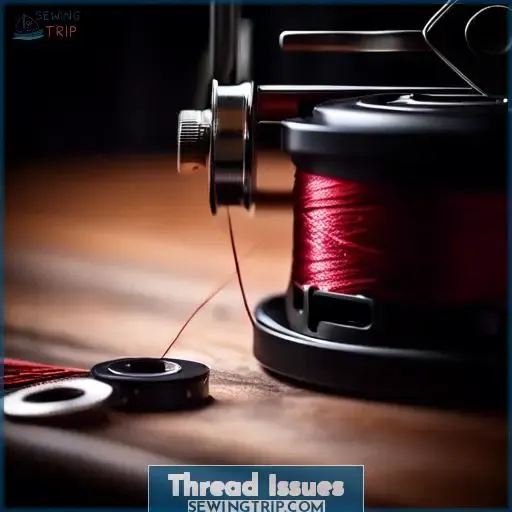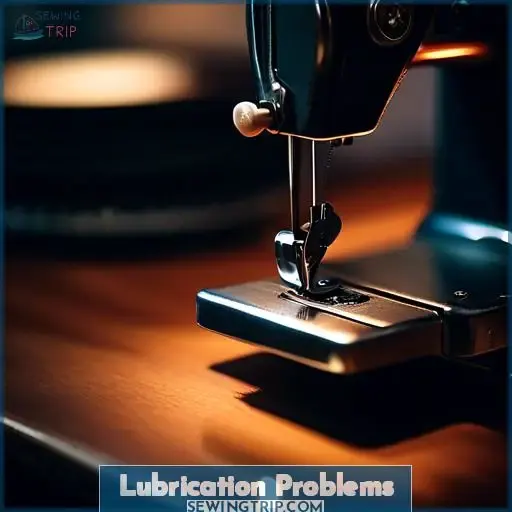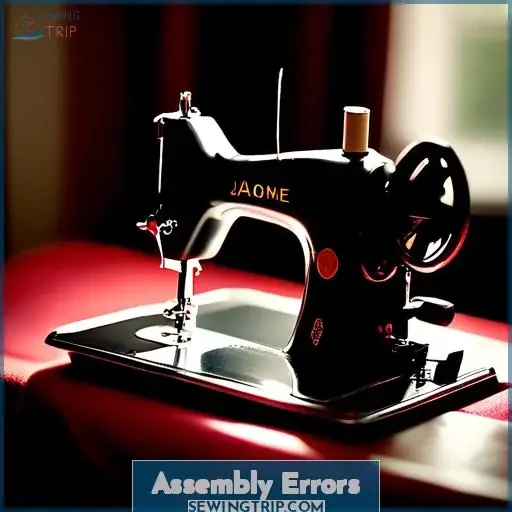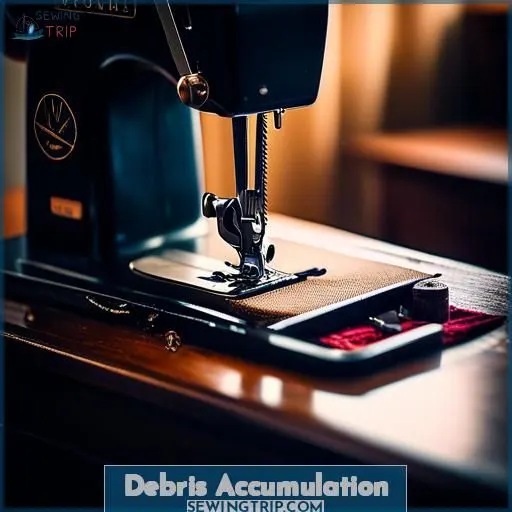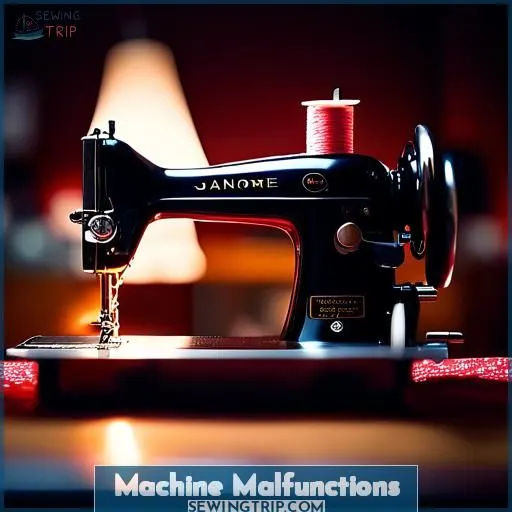This site is supported by our readers. We may earn a commission, at no cost to you, if you purchase through links.
First, make sure the bobbin case is threaded correctly and sits flat.
Next, align the bobbin case’s projection with the notch in the shuttle race, then press it firmly into place.
You’ll know it’s seated properly when it clicks into position.
An improperly inserted bobbin case can cause skipped stitches, tangles, and damage to your machine.
If you’re still having problems after reinserting the bobbin case, further troubleshooting steps may be required to resolve the issue.
Table Of Contents
Key Takeaways
- Ensure the bobbin case is threaded correctly and sits flat before inserting it into the Janome machine.
- Align the bobbin case’s projection with the notch in the shuttle race and press it firmly into place until it clicks.
- Regularly clean the bobbin case and oil the wick to prevent lint buildup and ensure smooth movement.
- If the bobbin case is severely damaged or worn, consider replacing it to maintain optimal performance.
How to Put the Bobbin Case Back in Janome?
To put the bobbin case back into a Janome sewing machine, follow these steps:
- Remove the bobbin case: Open the hook cover plate and draw the thread under the tension spring and into the delivery eye. Then, insert the hook cover plate back into its place.
- Replace the bobbin case: If the bobbin case is worn out, it may need to be replaced. Janome bobbin cases are available for about $35.00.
- Check the bobbin placement: Ensure the bobbin is placed in the bobbin case correctly.
- Clean the tension disc area: Make sure the tension disc area is clean.
- Check for damage: Inspect the bobbin case for any roughness or damage that could catch the thread.
- Reassemble the machine: Once you have replaced or repaired the bobbin case, reassemble the sewing machine and test it to ensure it is working properly.
Thread Issues
If you encounter thread catching on the spool holder or tangling beneath the bobbin case with your Janome sewing machine, it’s imperative to resolve these matters promptly. These difficulties can markedly affect the caliber of your sewing project and may necessitate adjustments or cleaning in particular areas of your machine.
Thread Catching on Spool Holder
If your Janome sewing machine is experiencing thread catching on the spool holder, several factors could contribute to this issue. Here are some steps to troubleshoot and potentially resolve the problem:
- Check thread tension: Make certain that the thread tension is appropriately adjusted. Loose thread tension can cause the thread to catch on the spool holder. Adjust the tension by following the instructions in your machine’s user manual.
- Needle size and bobbin type: Confirm that you’re using the correct needle size and bobbin type for your project. Using an unsuitable needle size or bobbin type can cause thread tension issues.
- Thread quality: Examine the quality of the thread you’re using. Substandard thread may not be strong enough to pass through the machine without snagging on the spool holder.
- Winding bobbin: Make sure that you’re winding the bobbin correctly. Incorrect winding can cause thread tension issues.
- Bobbin case: Inspect the bobbin case for any damage or rough spots that could be causing the thread to catch. Smooth out any rough areas with a nail file or similar tool.
- Machine servicing: If the issue persists, it may be necessary to have your machine serviced by a professional. A damaged or defective bobbin case could be the cause of the issue.
Thread Tangling Under Bobbin Case
When thread tangling under the bobbin case becomes your nemesis, it’s time to play detective. Check your bobbin tension—it should be just right, not too tight, not too loose. Are you using the correct thread type and needle size? They’re like a dynamic duo for smooth sewing. Peek inside the bobbin case; lint accumulation could be the unseen villain. Make sure the bobbin case is aligned perfectly, with its spur and groove in harmony. This isn’t just about fixing a snag; it’s about mastering your machine.
| Problem | Check | Solution |
|---|---|---|
| Thread Tangling | Bobbin Case Alignment | Align Spur & Groove |
| Lint Accumulation | Inside Bobbin Case | Clean Regularly |
| Incorrect Tension | Bobbin Tension | Adjust to Perfection |
Lubrication Problems
To address the issue of a rattling noise from the bobbin case after cleaning, it’s recommended to replace the bobbin case and confirm that it’s correctly inserted. Removing lint from under the bobbin case can help prevent it from shifting out of place.
If the problem remains, it may be necessary to lubricate the wick under the bobbin case to keep it oiled. This can be done by placing a drop of oil in the hole and running the machine until the wick is moistened.
Dry Oil Wick Under Bobbin Case
If you’re having problems with your Janome sewing machine, such as a rattling noise from the bobbin case after cleaning, it could be due to a dry oil wick under the bobbin case. Here’s a step-by-step guide to help you troubleshoot and potentially fix the problem:
- Check the oil wick: Inspect the oil wick located in the center of the bobbin case area. If it’s dry, apply a drop of sewing machine oil to the wick.
- Regular upkeep: Make sure to oil the wick regularly, as recommended in the user manual, to make sure it’s properly lubricated.
- Refer to the user manual: For specific instructions on maintaining your machine, refer to the user manual that came with your Janome sewing machine.
- Replace the bobbin case: If the bobbin case is badly worn or damaged, it may be necessary to replace it.
Machine Not Oiled Regularly
Machine not oiled regularly can lead to various problems in your sewing machine, such as a rattling noise from the bobbin case after cleaning or a clicking noise due to dry oil wicks under the bobbin case. To prevent these issues, it’s crucial to oil your machine according to its specific requirements.
First, determine the oil necessity and frequency for your machine. While some machines may not require oiling, others may need regular oiling to maintain ideal performance. For example, Sailrite recommends oiling their sewing machines every eight hours of use.
Next, choose the appropriate oil type. Sewing machine oil is typically a clear, odorless, and non-staining liquid that’s derived from petroleum and designed to lubricate the machine’s moving parts. Avoid using other types of oil, such as vehicle oil, as they aren’t suitable for sewing machines.
To apply the oil, locate the oil wick, which is usually found beneath the bobbin case or in the center of the bobbin case area. Apply a drop of oil to the wick after every 20 hours of use, as recommended by many manufacturers. Be sure to follow the specific instructions in your machine’s user manual for oiling frequency and methods.
Regular oiling will help prevent issues like thread breakage due to a worn or damaged bobbin case. It will also keep your machine running smoothly and quietly, extending its lifespan and ensuring dependable performance.
Assembly Errors
To insert the bobbin case back into your Janome sewing machine, follow these steps:
- Verify that the bobbin case is clean and void of any debris or lint that may obstruct its movement.
- Confirm that the bobbin case is oriented correctly with the horns at the back facing the rear of the machine.
- Place the bobbin case so that the groove underneath it fits into the corresponding groove on the metal hook race.
- Align the small projection on the front right of the bobbin case with the left of the metal stopper on the main body.
- Guarantee there’s a small amount of slack in the bobbin holder relative to the hook race for thread passage.
- Position and secure the bobbin case appropriately before closing the cover.
Recall to smooth any rough or uneven areas on the bobbin case with a nail file or similar tool to guarantee proper machine sewing. If the bobbin case is severely damaged or worn, contemplate replacing it.
Incorrect Bobbin Case Insertion
After resolving lubrication issues, let’s tackle another obstacle: improper bobbin case insertion. It’s like threading a needle in the dark if you overlook the bobbin tension and thread path. A misaligned case can result in bobbin jumping, similar to a square peg in a round hole. Verify that the case’s flat seam is facing you, avoiding those irritating needle strikes.
Bobbin Case Not Seated Properly
If your Janome sewing machine’s bobbin case isn’t seated correctly, it could be due to a few reasons. Here are three things you can check to troubleshoot the problem:
- Bobbin Case Alignment: Make sure that the bobbin case is correctly aligned with the machine. The groove underneath the bobbin case should fit into the corresponding groove on the metal hook race. If the alignment is off, the bobbin case may not seat properly.
- Bobbin Case Wear: Over time, the bobbin case may wear out, causing it to become misaligned or loose. If the bobbin case is worn, it may need to be replaced.
- Debris Accumulation: Lint or other debris can accumulate in the bobbin case area, impeding movement and causing the bobbin case to become misaligned. Regular cleaning of the bobbin case can help prevent this issue.
Remember to consult your user manual for specific instructions on how to properly maintain and align your bobbin case. If the issue persists, consider seeking expert assistance or consulting a professional for a thorough inspection and repair.
Debris Accumulation
Lint and debris can easily accumulate under the bobbin case, impeding its smooth movement. Regularly cleaning the bobbin case area and the oil wick is essential to prevent issues like thread breakage and machine malfunctions.
Lint Under Bobbin Case Impeding Movement
If you’re experiencing issues with lint accumulating under your bobbin case, it can impede movement and affect the performance of your Janome DC2010 or Husqvarna Saphirre. To address this, make sure the bobbin case is aligned and tensioned properly, and lubricate it regularly.
Clean the bobbin case regularly, and replace it if it’s worn down or damaged.
If the issue persists, consider seeking expert advice or consulting your user manual for specific instructions on cleaning and maintaining your machine.
Lint Clogging Oil Wick
Lint accumulation can obstruct the oil wick, hindering lubrication and leading to problems with the bobbin case.
To avert this, maintain your machine by cleaning and lubricating the bobbin case periodically.
Upon reinstalling the bobbin case, make sure it has a degree of flexibility or laxity for thread passage.
In the event that the bobbin case is damaged or worn, consider replacing it.
If the issue persists, refer to the user manual or seek professional advice.
Machine Malfunctions
A damaged or defective bobbin case can cause a multitude of sewing issues, from skipped stitches to thread breakage. If you’ve inspected and cleaned the bobbin case thoroughly, yet the problem persists, your machine may require professional servicing to address potential internal malfunctions hindering its performance.
Damaged or Defective Bobbin Case
Continuing from the pesky lint issues, let’s tackle a trickier beast: a damaged or defective bobbin case. Here’s what you need to know:
- Bobbin case replacement isn’t a bank-breaker; it’s a stitch-saver.
- Hook wear can turn your sewing saga into a horror story.
- Check your warranty coverage; it might just cover the cavalry costs.
Machine Requiring Servicing
If your Janome sewing machine is producing a rattling noise after cleaning the bobbin case, it may be time for maintenance.
This could be attributed to a worn hook on the bobbin case, which can lead to thread breakage and other problems.
If the noise persists, consider replacing the bobbin case or seeking professional advice.
Regular service maintenance every 12-24 months can help avert these malfunctions and guarantee the best performance.
Frequently Asked Questions (FAQs)
How do I properly clean and maintain the bobbin case on my Janome machine?
You’ll want to remove lint buildup and debris regularly using a soft brush or compressed air. Gently smooth any rough spots on the case using a fine nail file. Oil the wick sparingly – just a drop or two of machine oil goes a long way.
What should I do if the bobbin case is not seating properly in my Janome machine?
Aha, the bobbin case being a rebel, eh? First, double-check that pesky groove alignment – it’s like a lock and key. If it still won’t sit snug, a gentle filing might smooth any rough edges causing friction. But be careful, you don’t want to go overboard and mess up that precise fit.
How can I prevent the bobbin case from tangling under the bobbin case on my Janome machine?
Oh, the tangled web we weave! To prevent bobbin case tangles, make sure it’s inserted correctly – that little spur fitting snugly. Keep it lint-free; a quick brush will suffice. And hey, don’t be afraid to give it some well-deserved attention with a drop of oil!
What is the recommended oil for lubricating the wick under the bobbin case on my Janome machine?
For your Janome, use a high-quality sewing machine oil on that wick. A lightweight mineral or synthetic oil works best – just a drop or two should do the trick. While you’re at it, give all the moving parts a quick once-over with that oily rag too.
How often should I oil the bobbin case on my Janome machine to ensure optimal performance?
Oil the wick first, even if you fear it – a well-lubricated machine sews seamlessly. You’ll need to drip a bit every bobbin change, or monthly for frequent sewing.
Conclusion
Bottom line, getting the Janome bobbin case back in its proper place is key to smooth sailing.
When the bobbin case gets out of place, you’ll face skipped stitches and machine woes if you don’t put it back where it belongs.
Carefully follow the steps to reinsert the bobbin case.
Keep an eye out for lint buildup or damage.
With a well-oiled machine and the bobbin case securely seated, your Janome will be stitching like a dream again.


